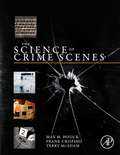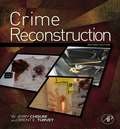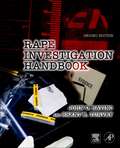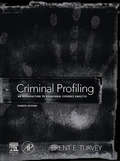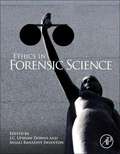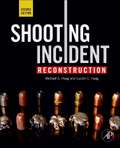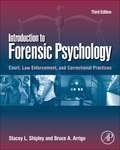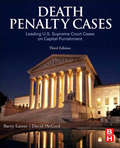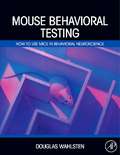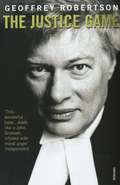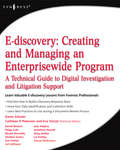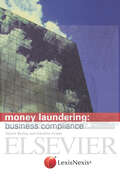- Table View
- List View
The Science of Crime Scenes
by Max M. Houck Frank Crispino Terry McAdamThe Science of Crime Scenes addresses the science of crime scene investigation and processing, including the latest methods and technologies. This book covers the philosophy of crime scenes as historical events, the personnel involved at a scene (including the media), the detection of criminal traces and their reconstruction, and special crime scenes, such as mass disasters and terrorist events. Written by an international trio of authors with decades of crime scene experience, it is the next generation of crime scene textbooks. The book provides in-depth coverage of disasters and mass murder, terror crime scenes, and CBRN (chemical, biological, radioactive and nuclear) – topics not covered in any other text. It includes an instructor website with lecture slides, test bank, outlines, definitions, and activities, along with a student companion site with an image collection. This text will be of interest to advanced undergraduate and graduate students in forensic science programs, as well as to forensic practitioners and crime scene technicians. Offers a science-based approach to crime scene investigationIncludes in-depth coverage of disasters and mass murder, terror crime scenes, and CBRN (chemical, biological, radioactive and nuclear) – not covered in any other textWritten by an international trio of authors with decades of crime scene experienceInstructor website with lecture slides, test bank, outlines, definitions, and activities, and a student companion site with an image collection
Crime Reconstruction
by Brent E. Turvey W. Jerry ChisumCrime Reconstruction, Second Edition is an updated guide to the interpretation of physical evidence, written for the advanced student of forensic science, the practicing forensic generalist and those with multiple forensic specialists. It is designed to assist reconstructionists with understanding their role in the justice system; the development and refinement of case theory’ and the limits of physical evidence interpretation. Chisum and Turvey begin with chapters on the history and ethics of crime reconstruction and then shift to the more applied subjects of reconstruction methodology and practice standards. The volume concludes with chapters on courtroom conduct and evidence admissibility to prepare forensic reconstructionists for what awaits them when they take the witness stand. Crime Reconstruction, Second Edition, remains an unparalleled watershed collaborative effort by internationally known, qualified, and respected forensic science practitioner holding generations of case experience among them. Forensic pioneer such as W. Jerry Chisum, John D. DeHaan, John I. Thorton, and Brent E. Turvey contribute chapters on crime scene investigation, arson reconstruction, trace evidence interpretation, advanced bloodstain interpretation, and ethics. Other chapters cover the subjects of shooting incident reconstruction, interpreting digital evidence, staged crime scenes, and examiner bias. Rarely have so many forensic giants collaborated, and never before have the natural limits of physical evidence been made so clear. Updates to the majority of chapters, to comply with the NAS Report New chapters on forensic science, crime scene investigation, wound pattern analysis, sexual assault reconstruction, and report writing Updated with key terms, chapter summaries, discussion questions, and a comprehensive glossary; ideal for those teaching forensic science and crime reconstruction subjects at the college level Provides clear practice standards and ethical guidelines for the practicing forensic scientist
Rape Investigation Handbook
by Brent E. Turvey John O. SavinoRape Investigation Handbook details specific investigative and forensic processes related to sex crimes casework invaluable to those in law enforcement, the legal community, and the private sector. It takes the reader through these processes in a logical sequence, showing how investigations of rape and sexual assault can and should be conducted from start to finish. The second edition is reorganized to flow from the alleged assault to a courtroom trial. Section heads have been introduced and it includes six new chapters on sex crimes, sex trafficking, forensic victimology, eyewitness reports, rape trauma syndrome and rapist motivations. The remaining 12 chapters are entirely overhauled and in some cases completely rewritten by new, highly qualified contributors, such as "Sexual Assault Examination and Reconstruction" by Brent E. Turvey and Charla Jamerson and "Rapist Motivations" by Brent E. Turvey and Jodi Freeman. An additional appendix was added to provide current case studies. Includes six new chapters on sex crimes, sex trafficking, forensic victimology, eyewitness reports, rape trauma syndrome and rapist motivations Written in a clear, practical style, ideal for sex crime investigators including: professionals in forensic nursing, forensic laboratories, law enforcement and the legal community Authored by qualified investigators and forensic professionals with over 30 years of collective experience working cases, preparing them for court and offering testimony
Criminal Profiling: An Introduction to Behavioral Evidence Analysis
by Brent E. TurveyFocused on Behavioral Evidence Analysis (BEA), a method of criminal profiling developed and refined by the author over the past 15 years, the fourth edition of Criminal Profiling maintains the same core foundation that made previous editions best sellers in the professional and academic community worldwide. Written from practicing behavioral analysts and aspiring students alike, this work emphasizes an honest understanding of crime and criminals. Newly updated, mechanisms for the examination and classification of both victim and offender behavior have been improved. In addition to refined approaches towards victimology, crime scene analysis, motivation and case linkage, a chapter on sexual deviance has been added as well. With prior edition in wide use as a primary text in criminal justice, law, criminology, and behavioral science programs around the world, Criminal Profiling, Fourth Edition remains essential for students and professionals alike. Outlines the scientific principles and practice standards of BEA-oriented criminal profiling, with an emphasis on applying theory to real casesContributing authors from law enforcement, academic, mental health and forensic science communities provide a balance perspectiveComplete glossary of key terms Companion Web site includes all appendices from previous volumes and figure collection at http://www.elsevierdirect.com/companions/9780123852434Manual Web site provides an instructor’s manual for each chapter, powerpoint slideshows, and case reports from Brent Turvey’s work
Ethics in Forensic Science
by J.C. Upshaw Downs Anjali Ranadive SwientonThis work will draw upon the expertise of the editors as authors and various contributors in order to present several different perspectives with the goal of approaching and understanding when ethical lines are crossed. In order to achieve this goal, comparisons of various canons of ethics from related fields such as medicine, law, the military, science and politics will be examined and applied. Case studies will be presented throughout to illustrate ethical dilemmas and challenge the reader with the goal of greater understanding. First book to comprehensively address ethics in forensics beyond the laboratoryReal-life cases presented involving unethical behavior to illustrate conceptsDiscusses ethical considerations while delineating opinion from fact in testimonyPlaces forensic ethics within the canons of the legal and medical systems
Shooting Incident Reconstruction
by Michael G. Haag Lucien C. HaagShooting Incident Reconstruction, Second Edition, offers a thorough explanation of matters from simple to complex to help the reader understand the factors surrounding ballistics, trajectory, and shooting scenes. Forensic scientists, law enforcement, and crime scene investigators are often tasked with reconstruction of events based on crime scene evidence, along with the subsequent analysis of that evidence. The use and misuse of firearms to perpetrate crimes from theft to murder necessitates numerous invitations to reconstruct shooting incidents. The discharge of firearms and the behavior of projectiles create many forms of physical evidence that, through proper testing and interpretation by a skilled forensic scientist, can establish what did and what did not occur. Written by the world's most well-respected shooting scene and ballistics experts, the book addresses the terminology, science, and factors involved in reconstructing shooting incident events to solve forensic cases. It covers the full range of related topics including: the range from which a firearm was discharged; the sequence of shots in a multiple discharge shooting incident; the position of a firearm at the moment of discharge; and the position of a victim at the moment of impact. The probable flight path of a projectile and the manner in which a firearm was discharged are also discussed. Case studies illustrate real-world application of technical concepts, supported by over 200 full-color diagrams and photographs. This book will be of value to practicing forensic scientists (firearm and toolmark examiners), ballistics experts, crime scene personnel, police departments, forensic consultants (generalists), attorneys and judges, medical examiners (coroners), and forensic pathologists.Written by the most well-respected shooting scene and ballistics experts in the worldContains over 200 full-color diagrams and photographs that support and illustrate key conceptsCase studies illustrate real-world application of technical concepts
Introduction to Forensic Psychology: Court, Law Enforcement, and Correctional Practices
by Bruce A. Arrigo Stacey L. ShipleyIntroduction to Forensic Psychology, Third Edition, has been completely restructured to explain in greater detail how courses on forensic psychology are taught, making it more applicable as a textbook than previous editions. It also features more figures, tables and text boxes, making it a true textbook. What this book has that others do not is equal representation of criminal behavior, the court systems, and law enforcement/prisons. It also has equal representation of criminal and civil forensics. Other texts tend to be weighted towards just criminal behavior or just criminal justice and primarily criminal or civic forensics but not both. This new edition also has equal representation of issues to pertaining to adults and children. It contains new coverage of cyberbullying, tests and assessments in the courtroom, mental deficiency and competency to stand trial, and information on mothers who kill their children. Adult, juvenile and family issues are dealt with separately, making it easier to find what you need. Case illustrations dramatically highlight how the lives of individuals have been (or could be) impacted by developments in psychology and law. Chapters now include pedagogy, including outlines, main points, and relevant websites. This book is intended for professors teaching introduction to forensic psychology, as well as for students interested in adult, child, and family forensics as they apply to criminal and civic forensics law enforcement/prisons. Newly structured to map closer to how this information is taught and learnedComprehensive coverage ensures inclusion of criminal and civic forensics as well as police and law enforcementChapters now include pedagogy, including outlines, main points, and relevant websites
Death Penalty Cases: Leading U.S. Supreme Court Cases on Capital Punishment
by Barry LatzerDeath Penalty Cases presents significant verbatim excerpts of death-penalty decisions from the United States Supreme Court. The first chapter introduces the topics discussed throughout the book. It also includes a detailed history of the death penalty in the United States. After this introduction, the remaining eighteen chapters are divided into five parts: Foundational Cases, Death-Eligible Crimes and Persons, The Death Penalty Trial, Post-Conviction Review, and Execution Issues. The first part, consisting of five chapters, talks about the mandatory death penalty, mitigating evidence and racial bias. The next part covers death-eligible crimes, such as rape and other crimes that do not involve homicide and murder. The middle part presents the trial process, from choosing the appropriate decision-makers through the sentencing decision. Followed by this is a chapter focusing on the aftermath of conviction, such as claims of innocence. The book concludes by exploring issues related to execution, such as not executing insane convicts. Finally, execution methods are presented. Provides the most recent case material--no need to supplementTopical organization of cases provides a more logical organization for structuring a courseCo-authors with different perspectives on the death penalty assures complete impartiality of the materialProvides the necessary historical background, a clear explanation of the current capital case process, and an impartial description of the controversies surrounding the death penaltyProvides the latest statistics relevant to discussions on the death penaltyClearly explains the different ways in which the states process death penalty cases, with excerpts of the most relevant statutes
Microbial Forensics
by Stephen A. Morse Bruce Budowle Steven E. Schutzer Roger G. Breeze Paul S. KeimMicrobial Forensics is a rapidly evolving scientific discipline. In the last decade, and particularly due to the anthrax letter attacks in the United States, microbial forensics has become more formalized and has played an increasingly greater role in crime investigations. This has brought renewed interest, development and application of new technologies, and new rules of forensic and policy engagement. It has many applications ranging from biodefense, criminal investigations, providing intelligence information, making society more secure, and helping protect precious resources, particularly human life. A combination of diverse areas is investigated, including the major disciplines of biology, microbiology, medicine, chemistry, physics, statistics, population genetics, and computer science. Microbial Forensics, Second Edition is fully revised and updated and serves as a complete reference of the discipline. It describes the advances, as well as the challenges and opportunities ahead, and will be integral in applying science to help solve future biocrimes. A collection of microbiology, virology, toxicology and mycology as it relates to forensics, in one referenceNew and expanded content to include statistical analysis of forensic data and legal admissibility and the standards of evidence, to name a fewIncludes research information and application of that research to crime scene analysis, which will allow practitioners to understand and apply the knowledge to their practice with ease
Forensic Dental Evidence: An Investigator's Handbook
by C. Michael C. BowersForensic Dental Evidence: An Investigators Handbook highlights the discussion regarding unjust convictions caused by inaccurate bitemark opinions. The book focuses on cases that use forensic techniques, emphasizing modern methods and protocols. Through this book, the latest information available is offered to the forensic community. This book demonstrates expertise in forensic dentistry by presenting chapters on human identification in domestic and international situations; investigations on missing person and violent crimes against persons; mass-disaster planning and disaster response; and new threats from terrorist attacks on urban centers. Furthermore, it discusses topics regarding bitemark evidence, such as forensic photography, analysis and legal issues. The book also presents two chapters on new scientific topics: The Next Level in Victim Identification: Materials Properties as an Aid in Victim Identification; and DNA for First Responders: Recognizing, Collecting, and Analyzing Biological Evidence Related to Dentistry (chapters 3 and 8, respectively). This book is suited to anyone seeking knowledge on forensic dentistry; it will be of great value to investigators, lawyers, medical examiners, nurses, and dentists with an interest in forensic dental cases. Contributions by internationally recognized and experienced forensic experts cover missing persons cases and mass disaster cases from around the worldContains over 200 full-color photographs of crime scene evidence, human identification cases and bitemark detailsIncludes many new exoneration cases derived from the Editor's work with the Innocence Project
Effective Interviewing and Interrogation Techniques
by Nathan J. Gordon William L. FleisherEffective Interviewing and Interrogation Techniques believably answers the question, How do you know when someone is lying? It also provides a guide for interviewing probable suspects and interrogating likely perpetrators on techniques and tradecraft. This book covers topics about searching for truth and revealing lies. It presents forensic assessments based on psychophysiology, and assessments on the basis of non-verbal behavior. The book also covers interview and interrogation preparation, as well as question formulation. It discusses the Morgan Interview Theme Technique or MITT, and the Forensic Assessment Interview or FAINT. The book addresses techniques for interviewing children and the mentally challenged, and offers information about pre-employment interviews. It also explains how to understand aggressive behavior and how to deal with angry people. The book concludes by presenting future methods for searching for the truth. Law enforcement and security professionals, as well as prosecutors, criminal defense lawyers, and civil litigators will find this book invaluable.The only book to address FAINT, IIT, and MITT in one sourceEnables the interviewer to obtain a confession that can stand up in courtIncludes an online workbook with practical exercises to assist the reader
Forensic Criminology
by Brent E. Turvey Wayne Petherick Claire E. FergusonForensic Criminology gives students of criminology and criminal justice an introduction to the forensic realm and the applied forensic issues they will face when working cases within the justice system. It effectively bridges the theoretical world of social criminology with the applied world of the criminal justice system. While most of the competing textbooks on criminology adequately address the application and the social theory to the criminal justice system, the vast majority do not include casework or real-world issues that criminologists face. This book focuses on navigating casework in forensic contexts by case-working criminologists, rather than broad social theory. It also allows criminology/criminal justice instructors outside of the forensic sciences the ability to develop and instruct a core course that might otherwise be considered beyond their expertise, or in conflict with forensic courses taught in chemistry, biology, or medical programs at their institutions because of its focus on criminology and criminal justice careers. With its practical approach, this textbook is well-suited for forensic criminology subjects being taught and developed in law, criminology, and criminal justice programs around the world. Approaches the study of criminology from an applied standpoint, moving away from the purely theoretical Contains relevant and contemporary case examples to demonstrate the application of forensic criminology Provides an integrated philosophy with respect to criminology, forensic casework, criminal investigations, and the law Useful for students and professionals in the area of criminology, criminal justice, criminal investigation, forensic science, and the law
Crime Scene Photography
by Edward M. RobinsonCrime Scene Photography, Second Edition, offers an introduction to the basic concepts of forensic picture-taking. The forensic photographer, or more specifically the crime scene photographer, must know how to create an acceptable image that is capable of withstanding challenges in court. The photographic theory and principles have to be well grounded in the physics of optics, the how-to recommendations have to work, and the end result must be admissible in court. Based on the author's years of experience in the field at both the Arlington County and Baltimore County Police Departments, this book blends the practical functions of crime scene processing with theories of photography to guide the student in acquiring the skills, knowledge, and ability to render reliable evidence. This text has been carefully constructed for ease of use and effectiveness in training and was class-tested by the author at George Washington University. Beginning August 2008, this book will be required reading by the IAI Crime Scene Certification Board for all levels of certification (through August 2011).Over 600 full color photographsTwo new chapters on 'The History of Forensic Photography,' and 'Digital Image Processing of Evidentiary Photography'An essential reference for crime scene photography, including topics such as Composition, the Inverse Square Law, Court Cases affecting photography, Digital Image Processing, and PhotogrammetryRequired reading by the Crime Scene Certification Board of the International Association for Identification (IAI) for all levels of certification
Mouse Behavioral Testing: How to Use Mice in Behavioral Neuroscience
by Douglas WahlstenMouse Behavioral Testing: How to Use Mice in Behavioral Neuroscience provides detailed explanations of how to conduct an experiment on mouse behavior from the initial planning of the research design through every step of the process until the data analysis phase. The book discusses the practical matters that need to be considered carefully when working with any species of animal, such as how many animals need to be tested. It describes the tests and techniques devised specifically for work with mice. Every step of the research process is illustrated with real situations encountered in previous studies. All examples are based on real experiments, and extensive details of several published experiments are provided. The essential features of a behavioral test protocol are outlined, and several complete protocols are provided. Methods to balance the order of tests and determine throughput are described, then a completely balanced order of tests in a complex experiment is presented. The book will be useful for those already familiar with the general principles of research but are new to the realm of behavioral testing of live mice. It will also serve as a text for a formal course, most likely at the graduate level. A guide to running a behavioral testing lab, including the many aspects of mouse research beyond the confines of the specific testDiagrams and photographs are shown for many kinds of apparatus and test situations with sufficient details such as dimensions to enable building of replicasProvides step-by-step instructions on planning and executing behavioral experiments in order to run them successfully
The Justice Game (PDF)
by Geoffrey RobertsonGeoff Robertson was born in Australia, bu came to London in 1970. He made his name as the fearless defender of Oz magazine at the celebrated trial and went on to engage in some of the most newsworthy cases in recent history. He has defended John Stonehouse, Cynthia Payne, Salman Rushdie, Kate Adie, Arthur Scargill, Daniel Sullivan, Gay News, 'The Romans of Britain', 'Niggaz with Attitude', and a pair of foetal earrings. The book includes accounts of recent cases including the defence of a West London gym owner against the Prince of Wales, the Matrix Churchill affair, and the defence of the Guardian in the cash-for-questions affair. Hugely readable, funny, scandalous, revelator, this will become one of the great books about the law.
Effective Interviewing and Interrogation Techniques
by Nathan J. Gordon William L. FleisherEffective Interviewing and Interrogation Techniques believably answers the question, How do you know when someone is lying? It also provides a guide for interviewing probable suspects and interrogating likely perpetrators on techniques and tradecraft. This book covers topics about searching for truth and revealing lies. It presents forensic assessments based on psychophysiology, and assessments on the basis of non-verbal behavior. The book also covers interview and interrogation preparation, as well as question formulation. It discusses the Morgan Interview Theme Technique or MITT, and the Forensic Assessment Interview or FAINT. The book addresses techniques for interviewing children and the mentally challenged, and offers information about pre-employment interviews. It also explains how to understand aggressive behavior and how to deal with angry people. The 4th Edition adds several Chapters on how to ascertain maximum information from victims and witnesses. The book concludes by presenting future methods for searching for the truth. Law enforcement and security professionals, as well as prosecutors, criminal defense lawyers, and civil litigators will find this book invaluable.The only book to address FAINT, Integrated Interrogation Technique, Forensic Statement Analysis and MITT in one sourceSeveral Chapters on ascertaining information from witnesses and victimsEnables the interviewer to obtain a confession that can stand up in court
Effective Interviewing and Interrogation Techniques
by Nathan J. Gordon William L. FleisherEffective Interviewing and Interrogation Techniques believably answers the question, How do you know when someone is lying? It also provides a guide for interviewing probable suspects and interrogating likely perpetrators on techniques and tradecraft. This book covers topics about searching for truth and revealing lies. It presents forensic assessments based on psychophysiology, and assessments on the basis of non-verbal behavior. The book also covers interview and interrogation preparation, as well as question formulation. It discusses the Morgan Interview Theme Technique or MITT, and the Forensic Assessment Interview or FAINT. The book addresses techniques for interviewing children and the mentally challenged, and offers information about pre-employment interviews. It also explains how to understand aggressive behavior and how to deal with angry people. The 4th Edition adds several Chapters on how to ascertain maximum information from victims and witnesses. The book concludes by presenting future methods for searching for the truth. Law enforcement and security professionals, as well as prosecutors, criminal defense lawyers, and civil litigators will find this book invaluable.The only book to address FAINT, Integrated Interrogation Technique, Forensic Statement Analysis and MITT in one sourceSeveral Chapters on ascertaining information from witnesses and victimsEnables the interviewer to obtain a confession that can stand up in court
The Bioarchaeology of Metabolic Bone Disease
by Simon Mays Megan B. Brickley Rachel IvesThe Bioarchaeology of Metabolic Bone Disease, Second Edition is a comprehensive source dedicated to better understanding this group of conditions that have significant consequences for health in both past and present communities on a global scale. This edition presents an updated introduction to the biology and metabolism of mineralised tissues that are fundamental to understanding the expression of the metabolic bone diseases in skeletal remains. The extensive advances in understanding of these conditions in both bioarchaeological and biomedical work are brought together for the reader. Dedicated chapters focussing on each disease emphasise the integration of up-to-date clinical background with the biological basis of disease progression to give guidance on identification. New chapters covering anaemia and approaches to recognising the co-occurrence of pathological conditions have been included, reflecting recent advances in research. Boxes highlighting significant issues, use of information from sources such as texts and nonhuman primates, and theoretical approaches are included in the text. Each chapter closes with ‘Core Concepts’ that summarise key information. The final chapter reviews current challenges in bioarchaeology and provides directions for future research. This is a must-have resource for users at all career stages interested in integrating information on the metabolic bone diseases into bioarchaeological projects.Covers deficiencies of vitamin C and D, osteoporosis (age-related and secondary), Paget’s disease of bone, anaemia and approaches to disease co-occurrenceContains clear and user-friendly guidance for macroscopic, radiological and microscopic diagnosesHighlights current inquiries and debates in biological anthropology, bioarchaeology, palaeopathology, medical history and clinical/biomedical researchExtensive figures, most new or updated, provide invaluable information on biological processes and lesion expression through diagrams and photographs
Fundamentals of Forensic DNA Typing
by John M. ButlerFundamentals of Forensic DNA Typing is written with a broad viewpoint. It examines the methods of current forensic DNA typing, focusing on short tandem repeats (STRs). It encompasses current forensic DNA analysis methods, as well as biology, technology and genetic interpretation. This book reviews the methods of forensic DNA testing used in the first two decades since early 1980’s, and it offers perspectives on future trends in this field, including new genetic markers and new technologies. Furthermore, it explains the process of DNA testing from collection of samples through DNA extraction, DNA quantitation, DNA amplification, and statistical interpretation. The book also discusses DNA databases, which play an important role in law enforcement investigations. In addition, there is a discussion about ethical concerns in retaining DNA profiles and the issues involved when people use a database to search for close relatives. Students of forensic DNA analysis, forensic scientists, and members of the law enforcement and legal professions who want to know more about STR typing will find this book invaluable.Includes a glossary with over 400 terms for quick reference of unfamiliar terms as well as an acronym guide to decipher the DNA dialectContinues in the style of Forensic DNA Typing, 2e, with high-profile cases addressed in D.N.A.Boxes-- "Data, Notes & Applications" sections throughoutAncillaries include: instructor manual Web site, with tailored set of 1000+ PowerPoint slides (including figures), links to online training websites and a test bank with key
Serial Crime: Theoretical and Practical Issues in Behavioral Profiling
by Wayne PetherickSerial Crime, Second Edition, examines serial predatory behavior and is divided into two main parts. Part one deals with behavioral profiling, and covers a variety of critical issues from the history of profiling and the theoretical schools of thought to its treatment in the mainstream media. This updated edition includes new sections on the problems of induction, metacognition in criminal profiling, and investigative relevance. Part two deals more specifically with a number of types of serial crime including stalking, rape, murder, and arson. Chapters on each of these crimes provide definitions and thresholds, and discussions of the offenders, the crime, and its dynamics. Considerations for behavioral profiling and investigations and the development of new paradigms in each area are interwoven throughout. Topics are conceptually and practically related since profiling has typically seen most application in serial crimes and similar investigations. The unique presentation of the book successfully connects the concepts and creates links to criminal behavior across crimes—murder, sexual assault, and arson—something no other title does. The connection of serial behavior to profiling, the most useful tool in discovering behavior patterns, is also new to the body of literature available and serves to examine the ideal manner in which profiling can be used in conjunction with behavioral science to positively affect criminal investigations.Provides a theoretical and practical foundation for understanding the motivation and dynamics in a range of serial offensesIllustrates the promise, purposes and pitfalls of behavioral profiling in the investigation of various serial crimesNumerous case examples show the real world uses of behavioral profiling in investigations, as well as highlighting a variety of issues in understanding and investigating serial crime
Fundamentals of Forensic Science
by Max M. Houck Jay A. SiegelFundamentals of Forensic Science, Second Edition, provides an introduction to the basic principles of forensic science. The book begins at a crime scene and ends in the courtroom. The book is divided into six parts. Part 1 provides an overview of criminal justice and forensic science, covering the basics of crime scene investigation and the nature of evidence. Part 2 discusses analytical tools, including microscopy, Raman spectroscopy, mass spectrometry, atomic spectroscopy, and separation methods. Parts 3 to 5 discuss the various types of forensic evidence collected, categorized by the types of science employed in their analysis: physical science, chemical science, and biological science. These include pathology; anthropology and odontology; entomology; serology and bloodstain pattern analysis; DNA analysis; forensic hair examinations; forensic toxicology; fiber and paint analysis; friction ridge examination; and firearms and tool marks. Part 6 discusses the legal aspects of forensic science. The book is written for students with a background in basic science, and it is can be used in a one-semester or two-semester format. Vivid, full-color illustrations that diagram key concepts and depict evidence encountered in the fieldStraightforward unit organization that includes key terms, numerous feature boxes emphasizing Internet resources, historical events in forensic science, practical issues in laboratory analysis, and topics for further reading Effective pedagogy, including end-of-chapter questions, paired with a clear writing style makes this an invaluable resource for professors and students of forensic science
The Law of Emergencies: Public Health and Disaster Management
by Nan D. HunterThe Law of Emergencies discusses the legal framework for disaster response and emergency management. The book engages with and debates some of the most important Constitutional issues of our time, such as the tension between civil liberties and national security. It also examines how the law of emergencies plays out in the context of real life emergencies where individuals often have to make split-second decisions. It analyzes legal authority at the federal, state and local levels, placing the issues in historical context but concentrating on contemporary questions. This book includes primary texts, reader-friendly expository explanations, and sample discussion questions. Prior knowledge of the law is not necessary in order to use and understand this book. The contents are organized into 13 substantive chapters plus two additional chapters with problem sets, making the book especially easy to use for a separate course focused on law. The book leads students through the process of understanding both what the law requires and how to analyze issues for which there is no clear legal answer. It features materials on such critical issues as how to judge the extent of Constitutional authority for government to intervene in the lives and property of American citizens. At the same time, it also captures bread-and-butter issues such as responder liability and disaster relief methods. No other book brings these components together in a logically organized, step by step fashion. The book also features case studies of high-risk scenarios including pandemic flu, together with charts and text boxes for clarification. This book will be of interest to graduate and undergraduate students studying the major legal principles underlying emergency management and homeland security policy and operations; professionals in EM and HS; and private-sector risk managers.* Features case studies of high-risk scenarios including pandemic flu* Offers extensive analysis of legal issues from a distinguished scholar, together with charts and text boxes for clarification* Teaches readers how to think about issues crucial to the life and liberty of US citizens, including the limits of constitutional authority
E-discovery: A Technical Guide to Digital Investigation and Litigation Support
by Karen A. SchulerOne of the hottest topics in computer forensics today, electronic discovery (e-discovery) is the process by which parties involved in litigation respond to requests to produce electronically stored information (ESI). According to the 2007 Socha-Gelbmann Electronic Discovery Survey, it is now a $2 billion industry, a 60% increase from 2004, projected to double by 2009. The core reason for the explosion of e-discovery is sheer volume; evidence is digital and 75% of modern day lawsuits entail e-discovery.A recent survey reports that U.S. companies face an average of 305 pending lawsuits internationally. For large U.S. companies ($1 billion or more in revenue)that number has soared to 556 on average, with an average of 50 new disputes emerging each year for nearly half of them. To properly manage the role of digital information in an investigative or legal setting, an enterprise--whether it is a Fortune 500 company, a small accounting firm or a vast government agency--must develop an effective electronic discovery program. Since the amendments to the Federal Rules of Civil Procedure, which took effect in December 2006, it is even more vital that the lifecycle of electronically stored information be understood and properly managed to avoid risks and costly mistakes. This books holds the keys to success for systems administrators, information security and other IT department personnel who are charged with aiding the e-discovery process.*Comprehensive resource for corporate technologists, records managers, consultants, and legal team members to the e-discovery process, with information unavailable anywhere else*Offers a detailed understanding of key industry trends, especially the Federal Rules of Civil Procedure, that are driving the adoption of e-discovery programs*Includes vital project management metrics to help monitor workflow, gauge costs and speed the process
Money Laundering: business compliance
by Stuart Bazley Caroline FosterMoney Laundering: Business Compliance is a timely and user-friendly manual that shows you how to comply fully and effectively with the Money Laundering Regulations 2003. In the drive to halt funding terrorist activity, control of money laundering activity has risen high on the government’s agenda. The Money Laundering Regulations 2003 expand the regulator’s already wide powers. Failure to comply with anti-money laundering provisions prevents businesses functioning properly, carries severe financial penalties and can result in serious criminal sanctions. Using flowcharts, diagrams, checklists and bullet points, this book explains how you can spot activities that must be reported. It alerts you to when and how you must report and to do so within minimum business interruption; demonstrates how to ensure compliance with the regulatory framework; gives details on correct training procedures; tells you how to avoid falling foul of the stringent rules against tipping off; and arms you with the knowledge to avoid the pitfalls. With its uniquely practical approach and hands-on guidance, the book should be the first port of call for all those wanting to understand the regulations and the guidance notes. This book is essential reading for MLROs, directors, compliance officers, risk officers, finance directors and accountants, company secretaries and all those within the regulated sector.
Securing Intellectual Property: Protecting Trade Secrets and Other Information Assets
by Information SecurityMost employeers are astounded at how easily and quickly their proprietary information can get out of their control. In a large number of cases, theft of trade secrets often involves employees leaving a company to start their own business or work for a direct competitor.Nearly all books that address the topic of trade secrets have the “spy vs. spy" perspective. The author approaches the topic from a practical business perspective and not simply creating “paranoia" for paranoia’s sake. The material for this book comes from the author’s extensive work experience as a computer forensics consultant and manager on numerous theft of trade secrets cases.No-nonsense solutions to the most common intellectual property problems facing security managers, computer security professionals, corporate legal counsel, and human resource managersSample agreements and forms that address specific business needsCoverage of threats ranging from physical security lapses to hackers to social engineering
